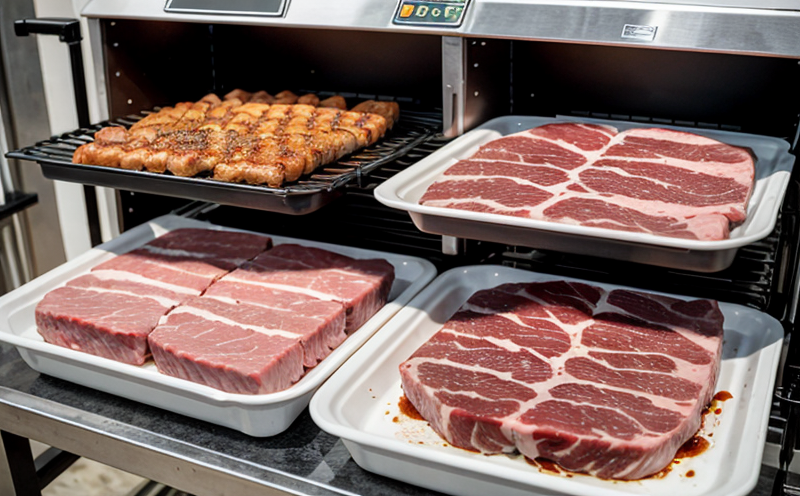ISO 3496 Collagen Quantification in Meat Products
The quantification of collagen in meat products is crucial for ensuring product quality, compliance with standards, and maintaining consumer confidence. ISO 3496 provides a standardized method for determining the total soluble protein content as an indicator of collagen quantity in meat products. This service ensures that food processors and manufacturers can accurately measure the collagen content to meet regulatory requirements and optimize product formulations.
The process involves extracting proteins from the meat sample, hydrolyzing them, and then measuring the absorbance at a specific wavelength using spectrophotometry. The results are compared against reference values established by ISO 3496 to determine the collagen content. This method is particularly important for products like sausages, bacon, and other processed meats where collagen plays a significant role in texture and binding properties.
Collagen quantification helps food companies identify potential issues early in the production process, such as raw material variability or processing inefficiencies. By leveraging this service, businesses can improve product consistency, enhance flavor profiles, and ensure that their products meet customer expectations and regulatory standards.
The testing procedure is designed to be robust and reproducible, ensuring accurate results across different batches of meat products. This reliability is critical for maintaining consistent quality in processed meats, which often undergo various treatments such as smoking, curing, or fermentation.
Collagen content can also influence the sensory properties of meat products, including texture, juiciness, and shelf-life stability. By quantifying collagen, food companies can optimize their formulations to achieve the desired eating experience while ensuring product safety and integrity.
The ISO 3496 method is widely recognized for its precision and accuracy in measuring total soluble proteins, which serve as a proxy for collagen content. This approach allows laboratories to provide consistent results that are comparable across different facilities and over time. The standardized protocol ensures that all measurements adhere to the same methodology, reducing variability and enhancing confidence in the testing process.
For food processors dealing with diverse raw materials or varying production conditions, this service offers a reliable way to monitor collagen content consistently. This capability is essential for maintaining high-quality standards across different batches and ensuring compliance with international regulations.
In addition to its role in meat products, collagen quantification can also be used in the development of new formulations, such as emulsifiers or stabilizers. By understanding the exact amount of collagen present, food developers can fine-tune their recipes to achieve optimal performance and consistency.
This service is particularly valuable for businesses involved in quality assurance programs, ensuring that all products meet strict safety and efficacy standards. The ability to accurately measure collagen content enables companies to make informed decisions about ingredient sourcing and processing methods, ultimately leading to higher-quality end products.
Benefits
- Enhanced Product Quality: Accurate measurement of collagen ensures consistent product quality across different batches.
- Compliance with Standards: Ensures that products meet international and local regulatory requirements for safety and efficacy.
- Improved Flavor and Texture: By optimizing collagen content, food companies can enhance the sensory properties of their meat products.
- Cost Efficiency: Early identification of issues in raw materials or processing can prevent costly rejections and recalls.
- Innovation Support: Collagen quantification aids in the development of new formulations and product improvements.
Quality and Reliability Assurance
The ISO 3496 method for collagen quantification is designed to ensure high-quality, reliable results. The process begins with the precise extraction of proteins from the meat sample using a standardized protocol that minimizes variability. Once extracted, the proteins undergo hydrolysis, followed by measurement of absorbance at a specific wavelength.
The reliability of this method lies in its adherence to international standards, which are rigorously validated and regularly updated. This ensures that all measurements are consistent and comparable across different laboratories and over time. The standardized protocol also allows for easy replication, enabling quality assurance teams to verify results independently.
In addition to the protocol itself, the accuracy of collagen quantification is further enhanced by using advanced instrumentation such as spectrophotometers. These instruments provide precise measurements that are crucial for achieving reliable results. Regular calibration and maintenance of the equipment ensure that all readings remain accurate and consistent.
The robustness of the ISO 3496 method extends beyond the technical aspects of the testing process. It also involves a comprehensive quality management system that ensures every step of the procedure is conducted according to best practices. This includes strict adherence to sample preparation guidelines, precise measurement techniques, and meticulous record-keeping.
The reliability of collagen quantification is further bolstered by the expertise of our laboratory personnel. Trained professionals use their knowledge and experience to interpret results accurately and provide actionable insights for food manufacturers. The combination of advanced technology and skilled personnel ensures that every test result is both reliable and meaningful.
Environmental and Sustainability Contributions
Collagen quantification plays a crucial role in the sustainable management of meat products by ensuring efficient use of raw materials. By accurately measuring collagen content, food processors can optimize their production processes to minimize waste and maximize resource utilization.
The ability to quantify collagen also supports efforts to reduce environmental impact. By identifying areas where collagen levels are insufficient or excessive, manufacturers can adjust their formulations accordingly. This not only enhances product quality but also reduces the environmental footprint associated with overproduction or underutilization of raw materials.
Moreover, accurate collagen quantification helps in developing more sustainable meat products by enabling the use of alternative ingredients when necessary. For instance, if a particular batch of raw material is found to have lower collagen content than required, food companies can opt for alternative sources that meet the specified standards. This approach ensures that even with varied raw materials, product quality and sustainability remain consistent.
The focus on environmental responsibility extends beyond production processes. By ensuring high-quality meat products, this service also contributes to consumer satisfaction and trust in sustainable practices. This, in turn, fosters a positive reputation for food companies committed to responsible resource management.





